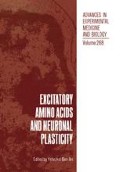Abstract
Over the past years considerable progress has been made towards understanding the biochemical and physiological significance of the N-methyl-D-aspartate (NMDA) type of excitatory amino acid receptor (for review see Cotman & Iversen, 1987). Receptor binding and electrophysiological studies have indicated that the NMDA-receptor complex comprises a number of distinct structural domains through which its function may be regulated or pharmacologically modified. The domains identified so far are: (i) the glutamate-binding site; (ii) an allosteric site, where glycine and/or 1-aminocyclopropane-l-carboxylic acid (ACC) regulate agonist-induced channel opening; (iii) a site (or sites) through which Mg2+ modulates the passage of ions; (iv) a site or sites that recognizes Zn2+ and prevents channel activation, and (v) a site or sites within the receptor channel for binding of drugs such as phencyclidine (PCP)-like, MK-801 and ketamine.
Access this chapter
Tax calculation will be finalised at checkout
Purchases are for personal use only
Preview
Unable to display preview. Download preview PDF.
References
Ambar, I., Kloog, Y. and Sokolovsky, M., 1988, Solubilization of rat brain phencyclidine receptors in an active binding form that is sensitive to NMDA receptor ligands. J. Neurochem, 51: 133–140.
Cotman, C.W. and Iversen, L.L., (Eds.), 1987, Excitatory amino acids in the brain-focus on NMDA receptors. Trends in Neurosci, 10:263–265.
Foster, A.C. and Wong, E.H.F., 1987, The novel anticonvulsant MK-801 binds to the activated state of the N-methyl-D-aspartate receptor in rat brain. Br. J. Pharmacol, 91: 403–409.
Grenningloh, G., Rienitz, A., Schmitt, B., Methfessel, C., Zensen, M., Beyrenther, K., Gundelfinger, E.D. and Betz, H., 1987, The strychnine-binding subunit of the glycine receptor shows homology with nicotinic acetylcholine receptors. Nature (London), 328: 215–220.
Guy, H.R. and Hucho, F., 1987, The ion channel of the nicotinic acetylcholine receptor. Trends in Neurosci, 10: 318–321.
Haring, R., Kloog, Y. and Sokolovsky, M., 1986, Identification of polypeptides of the phencyclidine receptor of rat hippocampus by photoaffinity labeling with [3H]-azido phencyclidine. Biochemistry, 25: 612–620.
Haring, R., Kloog, Y., Kalir, A. and Sokolovsky, M., 1987, Binding studies and photoaffinity labeling identify two classes of phencyclidine receptors in rat brain. Biochemistry, 26: 5854–5861.
Honore, T., Drejer, J., Nielsen, M., Watkins, J.C. and Olverman, H.J., 1987, Molecular target size of NMDA antagonist binding sites. Eur. J. Pharmacol, 136: 137–138.
Ikin,A.F., Kloog, Y. and Sokolovsky, M., 1990, N-Methyl-D-aspartate (NMDA)/phencyclidine receptor complex of rat forebrain: purification and biochemical characterization. Biochemistry, submitted.
Johnson, K.M., Snell, L.D. and Morter, R.S., 1987, N-methyl-D-aspartate enhanced [3H]TCP binding to rat cortical membrane: effects of divalent cations and glycine. in: “Sigma opiod phencyclidine-like compounds as molecular probes in biology,” E.F. Domino and J.M. Kamenka, eds., NPP Books, Ann Arbor, MI, pp. 259–268.
Kloog, Y., Haring, R. and Sokolovsky, M., 1988a, Kinetic characterization of the phencyclidine-N-methyl-D-aspartate receptor interaction: evidence for a steric blockade of the channel. Biochemistry, 27: 843–88.
Kloog, Y., Nadler, V. and Sokolovsky, M., 1988b, Mode of binding of [3H1-dibenzocycloalkenimine (MK-801) to N-methyl-D-aspartate (NMDA) receptor and its therapeutic implication. FEBS Lett, 230: 167–170.
Tallman, J.F. and Gallager, D.W., 1985, The GABA-ergic system: a locus of benzodiazepine action. Ann. Rev. Neurosci, 8: 21–44.
Author information
Authors and Affiliations
Editor information
Editors and Affiliations
Rights and permissions
Copyright information
© 1990 Springer Science+Business Media New York
About this chapter
Cite this chapter
Ikin, A.F., Nadler, V., Kloog, Y., Sokolovsky, M. (1990). Characterization of Membranal and Purified NMDA Receptors. In: Ben-Ari, Y. (eds) Excitatory Amino Acids and Neuronal Plasticity. Advances in Experimental Medicine and Biology, vol 268. Springer, Boston, MA. https://doi.org/10.1007/978-1-4684-5769-8_13
Download citation
DOI: https://doi.org/10.1007/978-1-4684-5769-8_13
Publisher Name: Springer, Boston, MA
Print ISBN: 978-1-4684-5771-1
Online ISBN: 978-1-4684-5769-8
eBook Packages: Springer Book Archive

